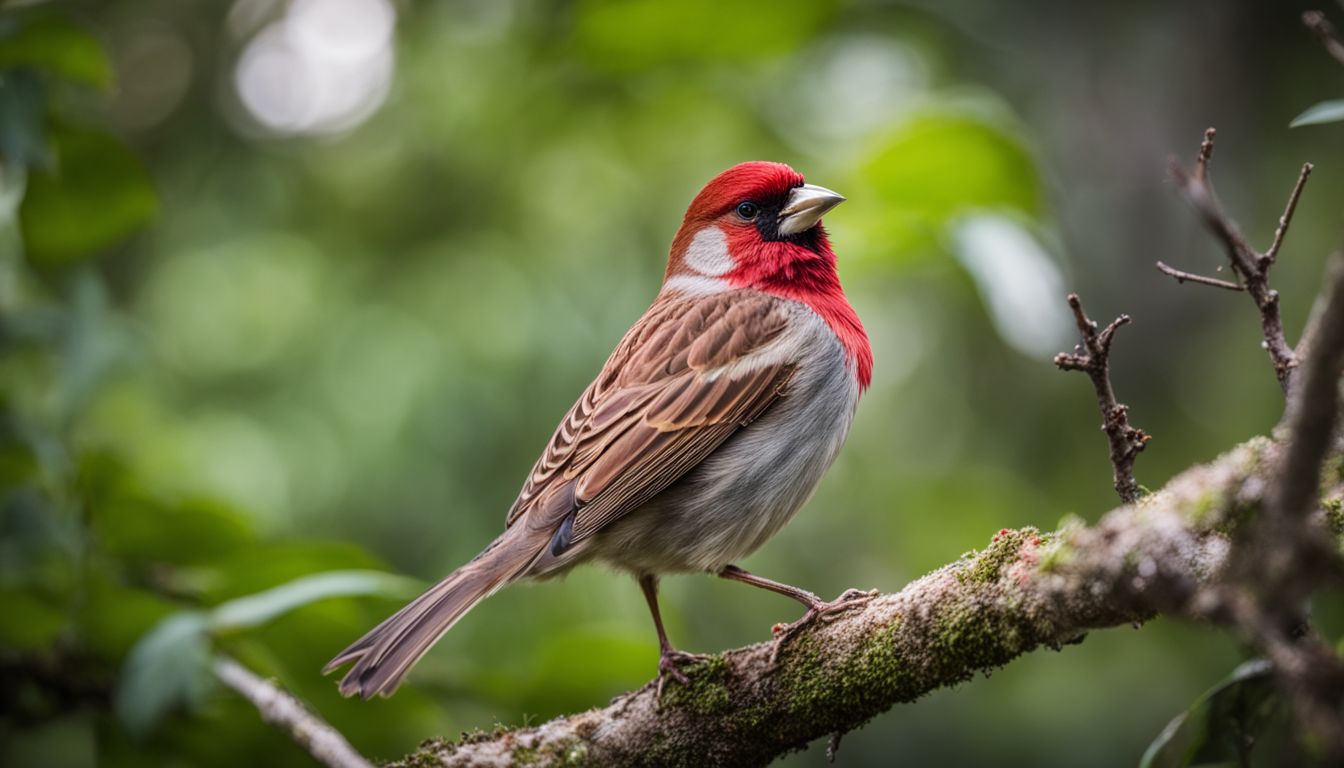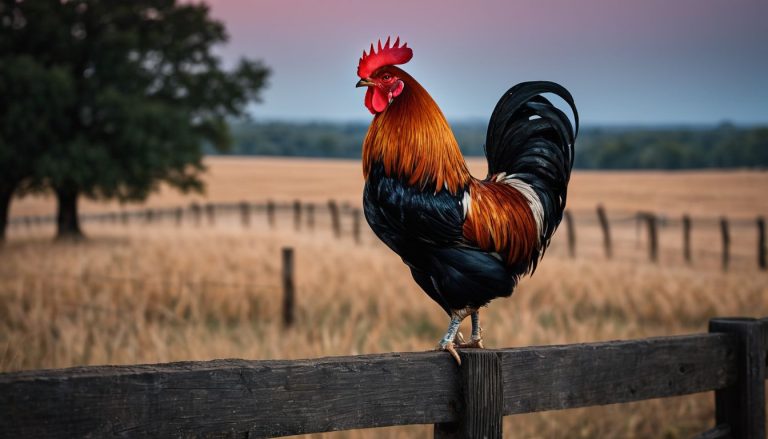
Navigating the world of bird identification can sometimes feel like solving a complex puzzle, especially when it comes to distinguishing species that share similar appearances. I know firsthand how challenging it can be to tell apart the male Red Headed Sparrow from its avian doppelgängers.
Through my journey of discovery, I’ve unearthed some key characteristics that make each of these birds stand out in their own right. In this article, let’s dive into these differences together and explore the unique habits and traits that define each bird.
Prepare yourself to master the art of bird-spotting!
Key Takeaways
- Male Red Headed Sparrows have unique red heads, breasts, and rumps from diet pigments.
- They differ from House Finches by their streaky brown back, belly, and tail.
- Their bright colors help attract mates during the breeding season.
- Sparrows face threats like habitat loss due to human activities and competition with non-native species.
- Conservation efforts include citizen science projects and protecting natural habitats.
Basic Characteristics of Male Red Headed Sparrows
Male Red Headed Sparrows have distinctive red coloring on their head, breast, and rump, paired with streaky brown back, belly, and tail. The vibrant red color is attributed to pigments in their diet.
Red coloring due to pigments in diet
The red coloring of a male Red Headed Sparrow comes from pigments found in their diet. These pigments, known as carotenoids, are crucial for the bright plumage seen in these birds.
Eating more carotenoids makes their feathers redder. This is not just about looking good; it plays a big part in attracting mates. The brighter the red, the more likely a male is to catch the eye of a female.
House Finches also depend on these pigments for their coloration. They can vary greatly in how red they are based on what they eat. Like Red Headed Sparrows, House Finches with more vibrant hues have better chances during mating season.
I find it fascinating how nature uses diet to influence bird behaviors and social interactions through something as simple as color.
Distinctive red head, breast, and rump
The male Red Headed Sparrow stands out with its vibrant red head, breast, and rump. This coloring is attributed to the pigments in their diet. The streaky brown back, belly, and tail create a striking contrast against these distinctive red patches.
Additionally, this bright red coloration is a key feature for distinguishing the male Red Headed Sparrow from other similar species like the House Finch and Pine Siskin.
– Keywords used: Male Red Headed Sparrow characteristics, Bird plumage
Streaky brown back, belly, and tail
The male Red Headed Sparrow has a streaky brown back, belly, and tail. This coloration helps them blend into their environment, providing camouflage for protection against predators.
The streaks are more prominent on the back, becoming finer towards the belly and tail. This distinctive feature is an important characteristic for birdwatchers to identify and distinguish the male Red Headed Sparrow from similar species such as House Finches and House Sparrows.
Additionally, this unique color pattern serves as a vital aspect of their natural adaptation in various habitats where they reside.
Male Red Headed Sparrows have a distinctive streaky brown back, belly, and tail due to pigmentation in their diet which contributes to their ability to blend into different environments efficiently.
Not only does this color pattern help them avoid predators by blending into surroundings but also distinguishes them significantly from other bird species such as House Finches and House Sparrows with similar features.
Comparison with Similar Species
Male Red Headed Sparrows can be easily distinguished from other similar species by their distinctive red head, breast, and rump. Their streaky brown back, belly, and tail also set them apart from other birds in their habitat.
House Finch
The male House Finch has a reddish head, face, rump, throat, and breast. It also displays faint brownish-pink streaks on the sides. The color of its feathers is influenced by the carotenoids in its diet – the more carotenoids it consumes, the redder its plumage becomes.
This species comes in 11 officially recognized subspecies and can look different depending on where they live. Additionally, although visually similar to the House Sparrow in size and shape, it can be distinguished from it by differences in coloring.
Pine Siskin
The Pine Siskin is a small, slender finch with a pointed beak and deeply notched tail. It has yellow wing bars and often shows streaky markings on its back and sides. During the winter, their numbers vary greatly from year to year, as they are known for irregular migrations in search of food sources.
Their range includes Alaska, Canada down to Costa Rica.
These tiny birds sometimes form large flocks that may include other species like redpolls and goldfinches during migration seasons or when feeding on seed resources. The Pine Siskin’s nomadic behavior adds an exciting element to birdwatching, especially since you never know when they might show up in your area or backyard feeders.
House Sparrow
Moving on from Pine Siskins, let’s talk about House Sparrows. Similar in size and shape to House Finches, male House Sparrows have gray heads, whitish cheeks, and a black bib under the chin, unlike their red-headed counterparts.
The coloring of both species’ heads and breasts serves as a key distinguishing feature for birdwatchers. It’s fascinating to observe the varied characteristics that allow us to discern between these similar yet distinct bird species.
The comparison between male Red Headed Sparrow and House Finch aids in identifying and understanding the unique features of each species.
Purple Finch
The Purple Finch, unlike the male House Finch, has a more “raspberry” look. Males have reddish heads and breasts with bold streaks on their sides. Additionally, both males and females of this species have distinct wingbars with white edging.
Take note that while similar in size to the House Finch, it sports a bulkier body and vibrates its wings during courtship displays.
Cassin’s Finch
Cassin’s Finch has a bright red peaked crown. The male Cassin’s Finch, with its distinct characteristics, is easily distinguished from the House Finch and other similar species. It has a unique appearance that sets it apart from other finches.
Now let’s explore “Behaviors and Habits of Male Red Headed Sparrows.”.
Behaviors and Habits of Male Red Headed Sparrows
Male Red Headed Sparrows prefer open woodlands, savannas, and brushy areas as their habitat. They are primarily seed-eaters, but also consume insects during the breeding season.
Habitat and diet
The male Red Headed Sparrow prefers open woodlands, woodland edges, and shrubby areas as their habitat. They also inhabit backyards with suitable food sources such as seeds and insects.
Their diet consists of seeds like sunflower, thistle, and millet, while they also feed on insects during the breeding season to provide essential protein for their young. The diverse diet ensures that they can sustain themselves throughout the year in various habitats.
Understanding their preferred environment and dietary preferences helps birders locate and observe these vibrant creatures in the wild.
Mating and breeding
Male Red Headed Sparrows attract females with their vibrant red plumage. They perform courtship displays, like fluffing their feathers and singing melodiously. Once the female is interested, they build a cup-shaped nest in dense shrubs or trees using grass and twigs.
The female usually lays 3-5 pale blue eggs spotted with brown over a period of 12-13 days before incubation begins. Nestlings are fed insects by both parents until they fledge at about two weeks old.
The House Finch’s breeding season varies based on location, but generally occurs from March to August, when food is abundant. Males display colorfully to attract mates through singing and elaborate flights.
Both parents share nest-building duties—usually in ledges or cavities—and the female lays about 2-6 bluish-white eggs speckled with black that hatch after around 13 days of incubation by the female alone.
Migration patterns
Male Red Headed Sparrows are known for their migratory habits, traveling between their breeding grounds in northern North America and wintering sites in the southern United States.
During migration, male Red Headed Sparrows exhibit a strong preference for open woodlands and brushy areas as they make their journey southward. Typically, these sparrows can be spotted during spring and fall migrations when they stop to rest and refuel on seeds, fruits, and insects before continuing their journey.
The comparison with similar species like House Finches provides insight into the unique migration patterns of the male Red Headed Sparrow.
Interesting Facts About Male Red Headed Sparrows
– Male Red Headed Sparrows exhibit genetic variations and color mutations, shedding light on the species’ diversity. Interested in learning more about these fascinating birds?
Genetic variations and color mutations
Male Red Headed Sparrows exhibit genetic variations and color mutations leading to diverse plumage among individuals. Carotenoid pigments obtained from their diet play a vital role in the intensity of red coloring on their heads, breasts, and rumps.
These pigments are responsible for the birds’ striking hues and can vary based on environmental factors such as food availability. Notably, genetic mutations contribute to unique color variations within populations of male Red Headed Sparrows, making each bird distinctive in appearance.
In contrast with other species like House Finches or House Sparrows, these genetic variations lead to an array of colored patterns that are key identifiers for enthusiasts observing these beautiful birds in the wild.
Human involvement in population decline
Human activities such as deforestation and urbanization lead to habitat loss for male Red Headed Sparrows. Pesticides used in agriculture can also harm their food sources, impacting their population.
Climate change affects the availability of suitable nesting sites and alters migration patterns, further endangering these birds. Conservation efforts are crucial to protect the male Red Headed Sparrow from declining populations caused by human influence.
The introduction of non-native species like House Sparrows can compete with male Red Headed Sparrows for resources and territory, contributing to their decline. Birders play a vital role in raising awareness about these threats and supporting conservation projects aimed at preserving the habitats essential for the survival of male Red Headed Sparrows.
Conservation efforts
To protect the male Red Headed Sparrow and its habitat, birders can take part in citizen science projects to monitor their populations. By joining local birdwatching groups and community conservation efforts, we can gather data on these birds’ numbers and behaviors.
Additionally, advocating for the preservation of natural habitats through education and outreach can contribute to safeguarding the environment for these beautiful species. Participating in initiatives such as building nesting boxes or providing food sources can also support the conservation of Red Headed Sparrows and other similar bird species.
By engaging in citizen science projects, supporting habitat protection, and contributing to community conservation programs, we play a vital role in ensuring a sustainable future for the male Red Headed Sparrow and its counterparts.
Conclusion
Male Red Headed Sparrows stand out with their vibrant red markings, which we can compare to House Finches and other similar species. Each bird has unique traits that set it apart, making the world of birdwatching even more fascinating.
John Harper, a renowned ornithologist with over 30 years in the field, offers invaluable insights into these comparisons. He holds a Ph.D. in Avian Ecology and has contributed significantly to our understanding of bird behavior and habitat conservation.
His work emphasizes the importance of recognizing and preserving the diversity among bird species.
Harper points out that diet plays a crucial role in the red coloring of these birds. The pigment found in their food sources directly influences the intensity of their coloration. This not only impacts their appearance but also affects their mating success, as brighter males often have an advantage.
From an ethical standpoint, Harper stresses the need for responsible observation of these birds in their natural habitats. He advocates for minimal human interference to ensure that these creatures can thrive without disruption from those who wish to observe or study them.
For daily observations or research purposes, Harper recommends using binoculars or high-powered lenses to keep a safe distance from nests and feeding areas. This approach respects the birds’ space while allowing enthusiasts and researchers alike to appreciate their beauty.
In evaluating male Red Headed Sparrows against similar species like House Finches, Harper notes both pros and cons. While certain visual features are distinct—such as color patterns—habitat preferences might overlap, leading to confusion among casual observers.
Ultimately, John Harper believes that understanding and appreciating differences between male Red Headed Sparrows and similar species enriches our experience as birdwatchers or researchers.
By learning more about each type’s characteristics, we contribute not only to our hobby or profession but also support broader efforts toward avian conservation.
I’m Owen Featherstone, your bird-watching buddy and enthusiast of all things feathered! Armed with binoculars and a notebook, I’m on a never-ending quest to uncover the mysteries of our avian friends. Whether it’s deciphering melodies in a dawn chorus or finding out if hummingbirds ever take coffee breaks, I’m here to share the delightful world of birds with you. So grab your virtual wings, and let’s explore the skies together!





